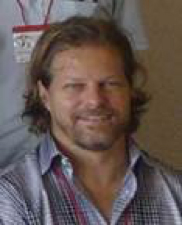August 14, 2015 - Energy Academic Group
The Next Generation of Photovoltaics
August 14, 2015
ME Lecture Hall
1300
Dr. Brian Korgel
Director, Industry/University Cooperative Research Center for Next Generation Photovoltaics, UT Austin
Abstract
Photovoltaic devices, or solar cells, convert sunlight directly into electricity. Sunlight offers a plentiful and renewable energy resource, and photovoltaics can produce electrical power anywhere that the sun shines. The first commercial solar cell was produced more than 60 years ago, and therefore, represents a relatively mature technology. However, dramatic improvements in solar cell technology over the last few years have led to significant cost reductions in manufacturing and use that now make photovoltaic electricity one of the cheapest sources of available energy. For example, large-scale solar farms "like the First Solar “Macho Springs" New Mexico project that provides electricity at only 5.8 cents/kWh offer the most inexpensive electricity available from any source. Commercial installations of solar cells can dramatically lower operating costs for large corporations; for example, Walmart is one of the largest end-users of photovoltaic electricity. However, these large-scale solar projects also create new challenges to the energy grid due to the intermittency of the sun and require new strategies for storing and delivering electricity to the end-user. Advances in materials science have also led to new semiconductor materials that can be used to create lightweight, pliant, and mechanically resilient photovoltaic devices that can be used as power-generating textiles and fabrics, as conformable coatings on vehicles, or architectural materials that could be seamlessly and temporarily embedded into buildings, rural environments and urban settings. These emerging light-weight and portable solar cell technologies have a vast range of military uses, including those needed for wearable electronic devices and sensors. This presentation will provide an introduction to solar cells and how they work, and provide examples of how solar cells are being used and how they will be used in the future.
Biography
Brian A. Korgel is T. Brockett Hudson Professor of Chemical Engineering at the University of Texas at Austin. He received his PhD from UCLA in 1997 and was a post-doctoral fellow at University College Dublin, Ireland. He works at the intersection of nano and mesoscopic materials chemistry and complex fluids, tackling problems in lithium ion batteries, photovoltaic devices and medicine. He has given 230 invited talks and has published 210 papers. He has been Visiting Professor at the University of Alicante in Spain, the University Josef Fourier in France and the Chinese Academy of Sciences in Beijing. He also directs the Industry/University Cooperative Research Center for Next Generation Photovoltaics, is an Associate Editor for the journal Chemistry of Materials and has co-founded two companies, Innovalight and Pion Technologies. He has received various honors including most recently the 2012 Professional Progress Award from the American Institute of Chemical Engineers (AIChE), election as a Fellow of the American Association for the Advancement of Science (AAAS) in 2012 and selection as an IUPAC Young Observer this year.
POC
Dr. Daniel A. Nussbaum
Naval Postgraduate School
Principal, Energy Academic Group
Monterey CA 93943
Phone: 831-656-2387
Mobile: 831-324-3228
Email: dnussbaum@nps.edu


